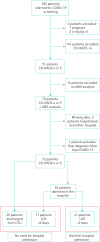Chest computed tomography and alveolar-arterial oxygen gradient as rapid tools to diagnose and triage mildly symptomatic COVID-19 pneumonia patients
- PMID: 33718488
- PMCID: PMC7898029
- DOI: 10.1183/23120541.00737-2020
Chest computed tomography and alveolar-arterial oxygen gradient as rapid tools to diagnose and triage mildly symptomatic COVID-19 pneumonia patients
Abstract
Background: In the coronavirus disease 2019 (COVID-19) pandemic, rapid clinical triage is crucial to determine which patients need hospitalisation. We hypothesised that chest computed tomography (CT) and alveolar-arterial oxygen tension ratio (A-a) gradient may be useful to triage these patients, since they reflect the severity of the pneumonia-associated ventilation/perfusion abnormalities.
Methods: A retrospective analysis was performed in 235 consecutive patients suspected for COVID-19. The diagnostic protocol included low-dose chest CT and arterial blood gas analysis. In patients with CT-based COVID-19 pneumonia, the association between "need for hospitalisation" and A-a gradient was investigated by a multivariable logistic regression model. The A-a gradient was tested as a predictor for need for hospitalisation using receiver operating characteristic curve analysis and a logistic regression model.
Results: 72 out of 235 patients (mean±sd age 55.5±14.6 years, 40% female) screened by chest CT showed evidence for COVID-19 pneumonia. In these patients, A-a gradient was shown to be a predictor of need for hospitalisation, with an optimal decision level (cut-off) of 36.4 mmHg (95% CI 0.70-0.91, p<0.001). The A-a gradient was shown to be independently associated with need for hospitalisation (OR 1.97 (95% CI 1.23-3.15), p=0.005; A-a gradient per 10 points) from CT severity score (OR 1.13 (95% CI 0.94-1.36), p=0.191), National Early Warning Score (OR 1.19 (95% CI 0.91-1.57), p=0.321) or peripheral oxygen saturation (OR 0.88 (95% CI 0.68-1.14), p=0.345).
Conclusion: Low-dose chest CT and the A-a gradient may serve as rapid and accurate tools to diagnose COVID-19 pneumonia and to select mildly symptomatic patients in need for hospitalisation.
Copyright ©The authors 2021.
Conflict of interest statement
Conflict of interest: M.P. de Roos has nothing to disclose. Conflict of interest: I.D. Kilsdonk has nothing to disclose. Conflict of interest: P-P.W. Hekking has nothing to disclose. Conflict of interest: J. Peringa has nothing to disclose. Conflict of interest: N.G. Dijkstra has nothing to disclose. Conflict of interest: P.W.A. Kunst has nothing to disclose. Conflict of interest: P. Bresser has nothing to disclose . Conflict of interest: H.J. Reesink has nothing to disclose.
Figures




Similar articles
-
Arterial Blood Gas as a Predictor of Mortality in COVID Pneumonia Patients Initiated on Noninvasive Mechanical Ventilation: A Retrospective Analysis.Indian J Crit Care Med. 2021 Aug;25(8):866-871. doi: 10.5005/jp-journals-10071-23917. Indian J Crit Care Med. 2021. PMID: 34733025 Free PMC article.
-
Chest CT in the Emergency Department for Diagnosis of COVID-19 Pneumonia: Dutch Experience.Radiology. 2021 Feb;298(2):E98-E106. doi: 10.1148/radiol.2020203465. Epub 2020 Nov 17. Radiology. 2021. PMID: 33201791 Free PMC article.
-
The Diagnostic Utility of Artificial Intelligence-Guided Computed Tomography-Based Severity Scores for Predicting Short-Term Clinical Outcomes in Adults with COVID-19 Pneumonia.J Clin Med. 2023 Nov 10;12(22):7039. doi: 10.3390/jcm12227039. J Clin Med. 2023. PMID: 38002652 Free PMC article.
-
Thoracic imaging tests for the diagnosis of COVID-19.Cochrane Database Syst Rev. 2020 Sep 30;9:CD013639. doi: 10.1002/14651858.CD013639.pub2. Cochrane Database Syst Rev. 2020. Update in: Cochrane Database Syst Rev. 2020 Nov 26;11:CD013639. doi: 10.1002/14651858.CD013639.pub3. PMID: 32997361 Updated.
-
Predictors of Intensive Care Unit admission in patients with coronavirus disease 2019 (COVID-19).Monaldi Arch Chest Dis. 2020 Jul 15;90(3). doi: 10.4081/monaldi.2020.1410. Monaldi Arch Chest Dis. 2020. PMID: 32672430
Cited by
-
Frequency and spectrum of incidental findings when using chest CT as a primary triage tool for COVID-19.Eur J Radiol Open. 2021;8:100366. doi: 10.1016/j.ejro.2021.100366. Epub 2021 Jun 25. Eur J Radiol Open. 2021. PMID: 34189189 Free PMC article.
-
Alveolar-Arterial Gradient Is an Early Marker to Predict Severe Pneumonia in COVID-19 Patients.Infect Dis Rep. 2022 Jun 15;14(3):470-478. doi: 10.3390/idr14030050. Infect Dis Rep. 2022. PMID: 35735760 Free PMC article.
-
The Association Between Alveolar-Arterial Oxygen Tension Difference and the Severity of COVID-19 in Patients.Infect Dis Ther. 2023 Feb;12(2):577-587. doi: 10.1007/s40121-022-00752-3. Epub 2023 Jan 5. Infect Dis Ther. 2023. PMID: 36602650 Free PMC article.
-
Comparison of positive pressure extubation with traditional extubation in critically ill patients - a randomised control study.Anaesthesiol Intensive Ther. 2023;55(1):38-45. doi: 10.5114/ait.2023.125584. Anaesthesiol Intensive Ther. 2023. PMID: 37306270 Free PMC article. Clinical Trial.
-
Oxygenation indices and early prediction of outcome in hypoxemic patients with COVID-19 pneumonia requiring noninvasive respiratory support in pulmonary intermediate care unit.Pneumonia (Nathan). 2024 Nov 25;16(1):22. doi: 10.1186/s41479-024-00145-9. Pneumonia (Nathan). 2024. PMID: 39582005 Free PMC article.
References
-
- World Health Organization. Clinical management of severe acute respiratory infection (SARI) when COVID-19 disease is suspected. Clinical management of COVID-19. Interim guidance. 27 May 2020. Geneva, WHO.
-
- Moammar MQ, Azam HM, Blamoun AI, et al. . Alveolar-arterial oxygen gradient, pneumonia severity index and outcomes in patients hospitalised with community acquired pneumonia. Clin Exp Pharmacol Physiol 2008; 35: 1032–1037. - PubMed
LinkOut - more resources
Full Text Sources
Other Literature Sources
